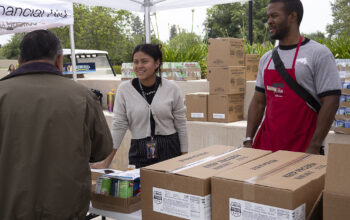The concern over the well-being of Pierce College students has been a determining factor in making sure the students feel like they are taken care of properly as this ranges from feeding hungry students with the food pantry to looking ahead in the vision for success.
The possible development of a Student Wellness Committee based on the needs of student economic security was discussed at the Pierce College Council meeting Thursday.
Chair of PCC Brian Walsh said he wants to create a committee with council members that can provide assistance to students who struggle with food insecurity, homelessness and health care.
The concept of having a food pantry not just because the state told us to have one, but to benefit the students was one of the first steps that Pierce thought was good, according to Walsh.
“I don’t want to have an improvisational approach,” Walsh said. “It would be good if this committee had in its charter as a part of its mandate to seek outside partnerships with non-profits. That’s something we could do.”
Chair of Modern Languages Department Fernando Oleas provided statistics based on a survey of the nine colleges which includes 230,000 plus students in the Los Angeles Community College District (LACCD).
“62.7 percent of students surveyed experience food insecurity, while 38.3 percent cite very low food insecurity, 55 percent experience some form of housing and 18.6 percent experienced homelessness,” Oleas said.
Oleas said he is in support of forming a task force committee that accommodates the student’s needs.
“If students are hungry in class you can’t concentrate and some students who leave may have a place to sleep and others that don’t is a definite problem,” Oleas said. “So, if we really want to help our students concentrate on education and become active members in our society and move forward in a positive way, we need to do something about this.”
Vice President of Student Services Earic Dixon-Peters said when looking at success rates some students who are coming here to finish their education are not staying on the path and struggles with food issues and housing are part of the reason.
“Some students say ‘I got sick or I don’t have money,” Dixon-Peters said. “I think having a task force will help us identify some strategies and or ideas that students are experiencing such as why are they successful and why are they not. Then this task force can make recommendations to the cause.”
Walsh said these issues should be broadened under the whole concept of economic support.
“I mean it’s like you can take classes here, but if you don’t have a home and food security it’s challenging,” Walsh said. “So, these concerns are now becoming a part of our mission, whether we like it or not.”
Dean of Institutional Effectiveness Amari Williams brought up the visions for success goals that are hoped to be achieved by 2022 will head to the Senate for approval in April.
“The first goal is that over five years, they hope to see an increase by at least 20 percent of the number of California Community College students who acquire associate degrees, credentials, certificates, or specific skill sets that prepare them for an in-demand job,” Williams said.
However, Admissions and Records Assistant Miguel Montanez said this means an increase in the number of educational counselors to accommodate the increase of students receiving degrees to complete their educational goals.
“More staff is going to be needed at the counseling and graduation offices along with more guided pathways coordinators and CTE counselors,” Montanez said.




